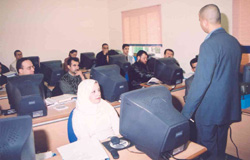You are here » Home » Telling Our Story
Photo & Caption
A Driver's License - For a Computer

| |
Photo: AMIR Program
|
|
"The Income Tax Department uses information technology to serve taxpayers better, so employees need excellent computer skills," says one Jordanian government official. "We've sent 289 employees to the International Computer Driver's License program so far, and 80 percent have been certified. The training has enhanced their ability to use computers for accounting, management and communications."
|
In 2000, Jordan launched a national e-government initiative, aiming to streamline government procedures and make information and services available to citizens on the Internet. At the time, however, most government employees did not have the technical skills to use a computer - much less administer e-government programs.
To help bridge this gap, USAID helped the Ministry of Information and Communications Technology implement the International Computer Driver's License program for computer literacy certification. Begun in August 2002, the first phase of the program taught more than 1,000 people from 19 government institutions basic computer skills, including how to use word processors, the Internet and email.
More than 70 percent of trainees rated the program "very good" or "excellent" - but only 45 percent passed the course. USAID worked with the ministry to revamp the program, integrating the results of an evaluation and suggestions from early participants, such as providing more practice time and creating a more accommodating schedule. In the second phase, the pass rate jumped to 80 percent.
"A key success factor in any training program is an effective evaluation process," said Amna Al-Kilani, head of change management for the e-government program at the ministry. "USAID assistance has helped us assess the program's performance and identify participants' needs to continuously improve the quality of our trainings."
By early 2004, more than 3,000 employees from 40 government institutions had taken the course, and demand for the program continues to grow.
Print-friendly version of this page (244kb - PDF)
Click here for high-res photo
Back to Top ^ | 

